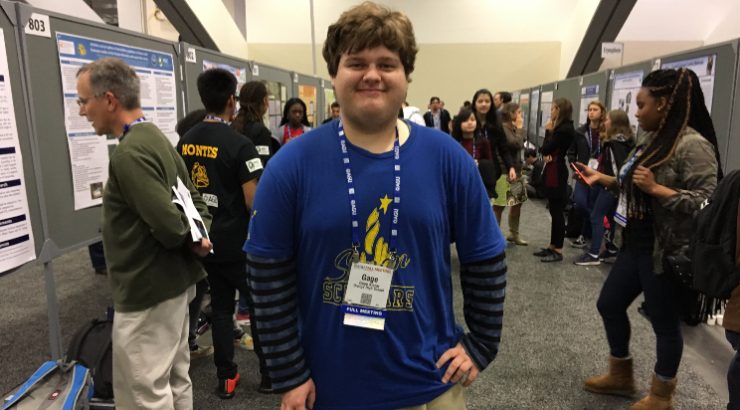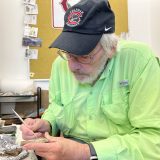
Simon STEM Scholar Attends AGU 2016 Fall Meeting
December 16, 2016
Gage Kizzar, a high school student from Orange High School, was selected in 2015 as a Simon STEM Scholar. As part of the partnership between Chapman University, The Simon Foundations and Orange High School, Kizzar has worked with faculty members of Schmid College of Science and Technology during Fall 2015, Spring 2016 and Fall 2016 terms. Kizzar and his fellow Simon STEM Scholars used satellite, EPA and GPS data under my guidance. I am Ramesh Singh and a professor of earth and environmental sciences at Schmid College.
The students who worked with me analyzed data to study:
- Dynamics of Pollutants Over Five Populous U.S Cities
- Changes in Rainfall, Water Vapor and Associated Parameters Along the Hurricane Matthew Track
Kizzar learned analysis tools to handle these data and studied dynamics of pollutants over five populous US cities and also changes in rainfall observed from satellite and GPS (Global Positioning System) data associated with the hurricane Matthew along its track, which hit the east coast of US during the period October 28 to November 10, 2016.

Gage Kizzar (center) with Prof. Ramesh Singh (right) and environmental science and policy major Allison Scavo ’17 (left) in the poster hall at the American Geophysical Union (AGU) Fall 2016 Meting.
Professor Andrew Lyon, Dean of Schmid College of Science and Technology, sponsored Kizzar’s visit to attend the Fall AGU meeting December 12-16, 2016, one of the largest meetings where 25,000 scientists attend to discuss all aspects of earth system science, land, ocean, cryosphere, biosphere, atmosphere and planets.
“I felt so excited and happy when I learned that I could go to San Francisco for this conference,” Kizzar said. During the conference, he got to talk to fellow students from other areas of the country and learn about their research from their colorful posters.
Each day he attended short films on science. The one that made the most impact was about how satellites detect the changes of the sun’s light through Venus’ atmosphere and how the team had to move so many coronagraphs all across the world.
In the poster hall, Kizzar saw posters of Bright Stars and interacted with the fellow students from other schools. He mentioned feeling motivated by other youth he met and thinking one could never be too young to appreciate science. The other students made him feel like he was part of a team of future scientists.

Gage Kizzar with Christine McEntee, AGU Executive Director and CEO AGU
During the meeting Kizzar also attended the Student Scholars Breakfast, where he met AGU CEO Christine McEntee and talked to other AGU Fellows. McEntee told me about her interaction with Kizzar, and she acknowledged that Kizzar is a bright student.
I certainly agree.

